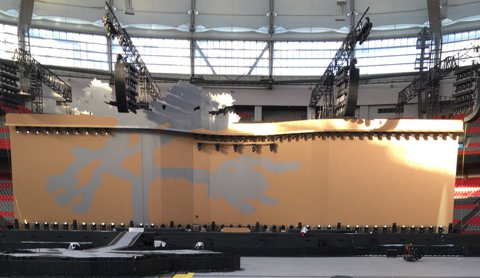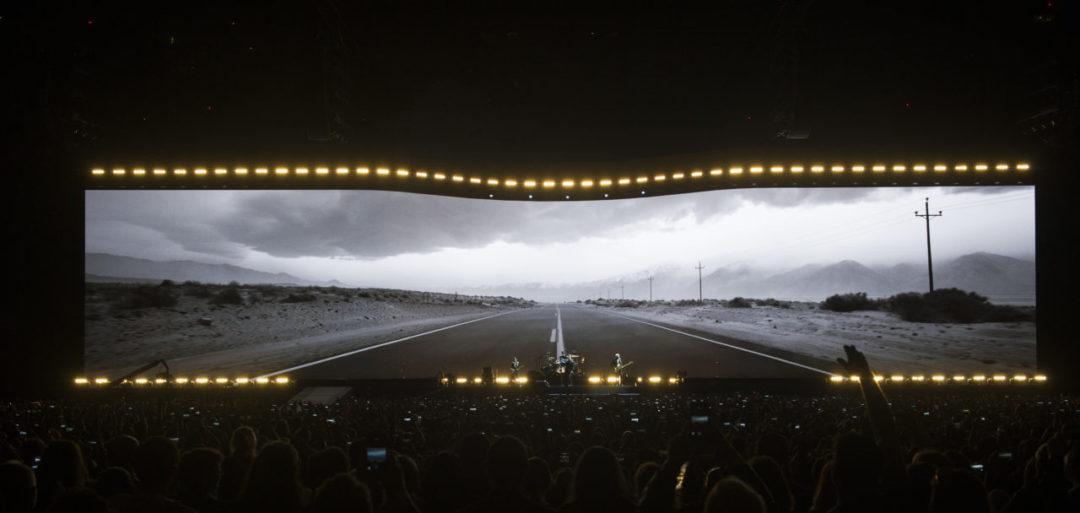This article was originally posted as part of Little Black Book’s Influencers series. Read the original article here.
After this weekend’s “The Joshua Tree” 30th-anniversary concerts in Twickenham Stadium, Toby Abbott reflects on thirty years with U2’s classic album and thirty years of advances in the industry.
A lot happens in thirty years, as was highlighted by one particular job we recently undertook. Not only did it accentuate how far technology and our expectations have changed, but also how music can trigger an avalanche of memories, transporting you to a point in your life when things were so much simpler. Anyone who’s worked within an editing environment will be well aware of the repetition of short music clips and dialogue as an editor probes, tweaks and crafts timings to instil emotions and a depth of understanding that is far greater than the length of time that the spot takes to play. It’s immersive to those cutting but to the surrounding staff it can sometimes bring you to the point of madness. This job was different though – we had three editors working on it solidly for three weeks with a further two for changes, revisions and final delivery. The snippets of sounds left me singing the next line and the only frustration inflicted was that I wanted the track to continue.
I was transported to the summer of 1987, a student at Plymouth college of Art and Design. My regular commute over Dartmoor to North Devon, to enable my mum to launder my dirty clothes and catch up with family and friends, was accompanied by the music of TalkTalk, Bowie, Hoodoo Gurus, Simple Minds, INXS and of course U2. It was, perhaps, a fleeting bubble of noise that for a short moment disturbed the peaceful grazing of sheep as I negotiated the snaking roads at break neck speed whilst screaming “ha la la la de day” at the top of my voice. The break neck aspect possibly more to do with the state of the knackered blue Citroën Dyane I drove than the actual speed I managed to prise out of its screaming engine. Only now do I fully appreciate the beauty of the scenery I traversed and what an idyllic life I led.
One of these visits home coincided with that of my brother Tim who was studying at the Poly of South Wales. He had, after some serious effort on his part, managed to sign us both and two friends up as stewards for the U2 Joshua Tree concert at Cardiff Arms Park. I for some bizarre reason turned this offer down and have, truth be known, regretted it ever since… In the absence of a music track and to get you in the right place, it was the year of the Great Storm, Terry Waite’s kidnapping, the Kings Cross fire, Arsenal winning the league beating Liverpool 2-1, Maggie Thatcher being re elected for a third term and The Joshua Tree climbed to number one in the album charts. U2 were on the verge of breaking into the US and the subsequent years brought them fame on a global scale with Rattle and Hum – The Edge’s live rendition of Van Diemen’s Land still sits up amongst my all time favourites.

I graduated, moved to London and began my career at SVC Television, bringing with it the new priorities and aspirations of work. U2 and my student life faded from my mind. The old Joshua Tree cassette was at some point lost in one move or another or perhaps some musical taste cleanse by my wife… who knows. Only now, by pure chance did the musical rediscovery at work bring with it the impetus to reach into the cloud and replace, or at least download, The Joshua Tree once more.
It’s resulted in a period of reflection on my life, my friends and what is important, but it has also highlighted the massive advances that have happened over the last 30 years. One month into 1987’s Joshua Tree tour, U2 headlined their first American stadium concert at Michigan’s Pontiac Silverdome, playing to an unprecedented number of fans. The reviews were positive, but called for video screens at future dates so that the band could be visible from any point in the crowd. U2 debated the suggested changes, fearing they’d distract and split the audience’s attention. As is now the case for any stadium performance, most of the remaining dates were fitted with the changes. Thirty years later, U2 are celebrating the anniversary of that double-Grammy award winning album by performing it in its entirety for the first time ever, beneath a 200 x 45 foot, 6K resolution screen – the size of three IMAX screens pushed together and the largest ever used in a touring performance. Just as the album’s legendary status has grown with each passing year, so too has the band’s penchant for scale and spectacle, it would seem.
Always eager to move forward, U2 have been reluctant to embrace the recent trend of “anniversary tours,” acknowledging the danger a band has of inheriting the abhorred moniker of “nostalgia act” when banking on the past, rather than touring new material. Accordingly, the band has worked with longtime collaborator, director Anton Corbijn, to produce a series of eleven original films, one for every track on the album. Just like the songbook that serves as their impetus, these films explore the myth of the American West, communicating the band’s fascination with its culture, its people and its landscapes. They evoke the feeling of that famous cover image, now synonymous with the band – a happy accident resulting from Corbijn’s decision to use a panoramic lens to take advantage of the vast Death Valley landscape, which forced the eponymous tree into focus and inadvertently birthed a legendary album title.

The films will play out on the tour’s enormous centrepiece screen, designed by longtime creative director Willie Williams and Stufish Entertainment Architects and built by Tait Towers. Adding to the effect of the 200-foot wide screen is the sparse set up on the stage itself – Willie Williams’ creative direction uses the original Joshua Tree tour’s traditional stage setup as a reference point. Huge custom-built structural beams have been designed so that the PA and lighting rigs hang above the screen rather than in front of it. The stage is completely uncluttered and allows for perfect clarity of image from anywhere in the stadium. In fact the only things obstructing line of site are the band members themselves – and against such an enormous background, there’s no danger of the image being obscured. Much has changed, then, since the band’s concerns over introducing video screens back in 1987, and yet the spirit remains intact. That tour’s backdrop, an enormous stretched-out image of a Joshua Tree splayed awkwardly across what looked like the world’s biggest sheet of black tarpaulin, is embraced and updated; the tree is silhouetted across the screen in silver on gold, extending above its frame, and casts a shadow out into the crowd, forming the concert’s B-stage.

Anton has previously worked with editor James Rose on many projects. This relationship has extended to our whole team at Cut+Run and Jogger Studios London, who have been a part of this creative journey throughout every step of the post-production process. I’m extremely proud of the team here, who threw so much time and effort into making this happen. James Rose, Jack Singer and Nick Armstrong at Cut+Run edited the films, which will play to a total of 1.7 million people over the course of the 33-date tour. With Jack and then James travelling to Vancouver to see the project through the two-week final stadium rehearsal and over the line, our team was a part of the process from the first stages of the offline edit, through to 6K delivery and the films’ debut on opening night of the tour. Having Jogger’s studios located upstairs meant we were able to complete all the work on this enormous project entirely in-house, with VFX by Jogger and a grade by our resident colourist Yoomin Lee.
This was especially relevant when the 6K workflow was put into perspective – the screen was so large and the interaction with lighting and the band playing live was so entrenched that a further tier of approvals was required. This took place throughout the last two weeks of rehearsal in Vancouver and it was only at this point that the screen and performance could be experienced together. “Where the Streets have no Name” was one long shot; not only did a duration change become necessary but also the seemingly smooth footage required stabilisation, such was the magnified nature of the enormous screens. The time difference worked to our advantage, rehearsals took place in the evenings and comments were fed through to London first thing in the morning, enabling us to revise, render and upload ready for the next days rehearsal.

Talking to various friends both here and in the US has highlighted the numbers who share a remarkably similar range of fond memories that this tour has evoked, bringing music to the forefront of their minds. It is huge, on so many fronts – a celebration of the band, the music, the technology and, on a personal level, a soundtrack to part of my generation’s life. U2 finally brought the spectacle to London’s Twickenham Stadium this weekend. Having eagerly tracked the US leg of the tour, the opportunity to witness months of hard work, build-up, pressure and anticipation manifested on the world’s biggest screen was certainly worth the wait.
To be honest my involvement was minimal (extremely) and the credit should go to the editors James, Jack, Nick, colourist Yoomin, the VFX team at Jogger and Ruth who produced at our end. But when Jack Singer returned from the rehearsals and first couple of concerts in Vancouver, he brought with him a tour program, I could hardly contain myself when he announced that the team had all been credited. My immediate thought was that I must show my brother and our two friends who’d attended to the original concert back in 87, not to show off but to connect, maybe even to apologise for turning my back on being part of that experience along side them, that only now after so much time I longed to be apart of. It was only as Jack handed me the Tour programme that he said, “You might not like your credit Toby.”
Those who know me well will be aware of my pet hate – it’s one that many people will perhaps relate to in this age of emails and auto corrections. I have a name that lends itself to regular correction, misinterpretation and perhaps just pure laziness on a stranger’s part. Despite the obvious hint in the email address and signature one would hope it’s enough to prompt a response that calls me by my name. Such has been the irritation over the years that my colleagues now refer to this alter ego as if it’s my own personal Mr. Hyde – he even has a voice reminiscent of a gangster who’d not look out of place in the Sopranos… Yes, you’ve guessed; my name has been credited as Tony. My memories, friendship and pride usurped by the modern technology that had proved the creator and catalyst for this trip down memory lane.
